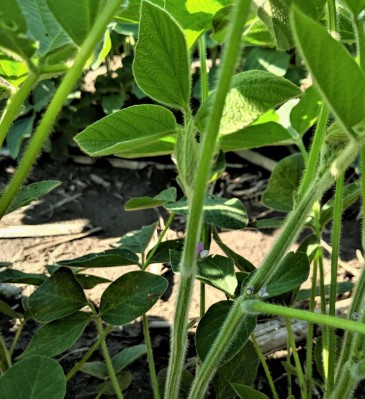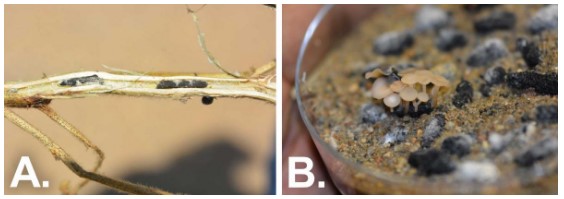By Emmanuel Byamukama
Frequent rains and overcast conditions continue to occur in South Dakota’s main soybean growing counties. These conditions favor white mold development. In some of these counties, soybean is already at R1 (Figure 1, beginning flowering), which is also the best timing for fungicide application targeting white mold control. It should be noted here that by the time white mold symptoms are seen in the field, it is quite late to apply a fungicide. The infected plants will not be able to recover. Therefore, white mold is one those diseases where a fungicide is applied prior to the disease symptoms onset.

Figure 1. Soybean plants with initial flowers, which indicate the R1 growth stage.
Disease Life Cycle
White mold, also known as Sclerotinia stem rot, is caused by a fungal pathogen, Sclerotinia sclerotiorum. This pathogen overwinters as a hardened fungal mass, called sclerotia, in the soil and soybean stem residues. Under cool (<80° F) and wet conditions, the sclerotia produce small mushroom-like structures, called apothecia, in the spring (Figure 2). The apothecia produce spores and when these land on senescing soybean flowers (usually the first set of flowers), infection is initiated. Once the infection girdles the entire stem, the plant starts to wilt and will eventually die. Depending on the growth stage when the entire plant is killed, yield loss can be over 40% due to white mold infection.

Figure 2: A. Sclerotia, black hardened fungal mass, which are the survival structures of the white mold pathogen. B. Sclerotia producing mushroom-like structures which are the source of spores that cause infection in soybeans.
Risk Factors
The extent of white mold development in a field is dependent on: field history of white mold, narrow row spacing/high planting population (>160,000 seeds per acre), susceptible cultivar, high soil fertility environment and conducive weather. Field history is important because white mold sclerotia can remain active in the field; specifically, where tillage is practiced. Narrow row spacing and high planting population provide early canopy closure. The shade, provided by the closed canopy, lowers the temperature underneath the canopy, which stimulates the sclerotia to start producing spores. Fields with high soil fertility levels, particularly where animal manure was applied, tend to have increased white mold risk. Variety white mold rating also influences the level of white mold development. Fields with a few of these risk factors; especially, history of white mold in the past may consider applying a fungicide to control white mold at R1 growth stage.
Management Strategy
The only in-season white mold management practice is the application of fungicides. To obtain the maximum benefits from a fungicide application, the time of application and type of fungicide to be applied are important. The best fungicide application timing for white mold protection is the R1 growth stage (beginning flowering). This application timing will protect the initial flowers from infections to take place. Fungicides that have been found to be effective against white mold include Aproach, Domark, Endura, Omega500DF, Propulse, and Proline. See this publication for a list of fungicides used to control diseases in soybeans.
Pre-planting white mold management can be achieved through a combination of various tactics. These include crop rotation, wider row spacing (>20 inches), planting tolerant varieties, and avoiding excessive nitrogen fertilizers such as animal manure.
Source: sdsu.edu